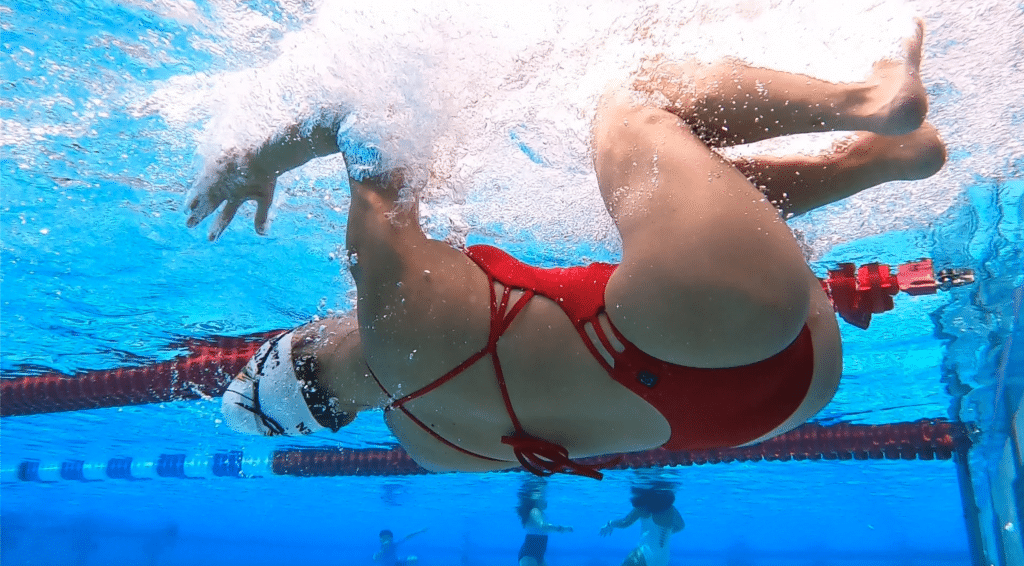Woof – it has BEEN a minute! What a wild and crazy end to 2020, and interesting start to 2021. I decided to take some time off for the holidays, and step away from my computer. It was a really needed break, but I am happy to be back on the horse. In today’s post, my plan is to give you Part III of our series on Swimming Crossover Turns and discuss which turn gives you the BEST Pullout!
Let’s get started!
As we discussed in Part I, there are 3 different styles of Crossover Turns. All of these styles have their own pros and cons to which we discuss in Part II – which one is best for YOU!
At the very end of Part II, I gave you all my general teaching order for these turns. For younger swimmers, I would start teaching them the Bottom Arm Spin Turn and from there, I’d progress my swimmers to the Top Arm Spin Turn. Finally for my more elite kids, they get to start learning the Backstroke Flipturn Modification Turn and hopefully master that.
My reasoning for this order is the turns get significantly more technical as you climb up that ladder, which means they all require more steps and body awareness. All of this is great if you’re swimmer is at this point and ready to learn it, but what happens if they aren’t? Also, what is the byproduct then to your pullout speed? Well, the harder your turn gets – the harder it is to also generate a HIGHER speed.
Why?
The reasoning for this is the same, as we discussed with the complication of the turn. The more complex Swimming Crossover turn you do (which for in this case it’s a Backstroke Flipturn Modification Turn) – the higher probability you have of potentially NOT hitting your wall well. See the video below:
It doesn’t matter what style of Swimming Crossover turn you’re doing, if you don’t plant yourself on the wall in a mini squat position with your fingertips pointing directly towards the other end – you’re going to end up with an array of problems.

The ideal pushoff position is with your knees somewhere between 60 to 90-degrees of knee bend. Your feet shoulder with apart. Your back straight, and your hands in a tight streamline before you push off.
Just like with any pushoff, the smaller the angle of your knees – the harder it is to produce power. So you don’t want your swimmers to be JAMMING into this wall. Coach them to finding a DEEP touch with a TON of side bend to open up their knee angle!
Get Your FREE Stroke Analysis!

So What Do I Do?
For one, practice. If you decide to do a more complicated turn, you’re going to need LOTS of practice. You can’t expect to learn the highest level of a Swimming Crossover Turn and then directly do it in a meet. You must do it for repeats (and more repeats). The more turns you can do at the highest technical level, the more you’ve practiced what happens when things don’t go right. Because normally, things don’t go accordingly to plan.
Here’s a video of my favorite Crossover Turn Drill to help you become more acquainted with this turn style:
The second thing is don’t overcomplicate it. While it is COOL to do the highest level of a Swimming Crossover Turn, for some swimmers it’s NOT worth performing to then push off in a junky bodyline. This bad body position will have a LARGER affect on that swimmer’s swim, than a bit slower turn with a BETTER bodyline.
The pushoff from a wall during any swimming race is the second HIGHEST speed produced for that swimmer – so don’t jeopardize that by trying to make your turn fancier than it needs to be.
The Reality?
If you’re just learning the Crossover Turn, become GREAT at the Bottom Arm Spin Turn. If you already know how to do a GREAT Bottom Arm Spin Turn, start learning the Top Arm Spin Turn. BUT, compete in meets with the Bottom Arm Spin Turn until you’ve done at least 100x Top Arm Spin Turns in practice. Then, same thing goes for the Backstroke Flipturn Modification Turn. You must have done at least 100x of these, before you perform one in a meet. Otherwise, just go back down one level, so your Breaststroke Pullout isn’t compromised on your next lap.
Until Next Time,
Abbie Fish
